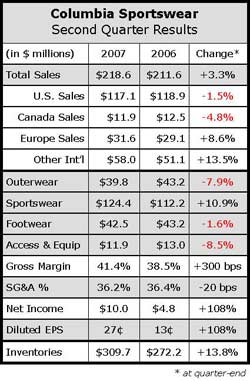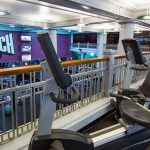Columbia hit record sales and earnings targets  during the second quarter in spite of a weak U.S. market and slow sell-through due to weather issues early in the quarter. Sales were driven by continued growth in the sportswear category and in major markets outside of North America. This growth was partially offset by weakness in the U.S. and Canada and a shift in timing of international distributor shipments to the third quarter of this year. By category, growth was driven primarily by sportswear with mid-single-digit declines in outerwear, footwear, accessories and equipment.
during the second quarter in spite of a weak U.S. market and slow sell-through due to weather issues early in the quarter. Sales were driven by continued growth in the sportswear category and in major markets outside of North America. This growth was partially offset by weakness in the U.S. and Canada and a shift in timing of international distributor shipments to the third quarter of this year. By category, growth was driven primarily by sportswear with mid-single-digit declines in outerwear, footwear, accessories and equipment.
While overall sales inched-up 3%, the bottom line grew substantially due to stronger gross margins and lower SG&A expenses. Gross margin increased due to improvements in sportswear margins, a higher mix of full price sales, and favorable foreign currency exchange rates. This improvement was partially offset by a higher mix of international distributor sales, which carry lower gross margins.
Selling expenses increased in absolute dollars, but decreased as a percentage of sales. Promotional spending and sample costs partially increased during the quarter, but sales commissions were down. Operating expenses were impacted by additional depreciation and amortization related to the implementation of Columbias new Portland and European distribution projects, offset by a decrease in personnel related costs.
U.S. sales of Columbia brand sportswear increased double-digits in the second quarter with solid growth in shipments of spring knit and woven tops and shorts. This strength was offset by softness in Columbia footwear and Columbia outerwear. U.S. retail sell-through “lagged behind” due to unseasonably cool and wet weather patterns during April and May and poor consumer retail traffic. Columbia management said that the company has experienced a higher level of U.S. spring order cancellations across all channels and most major regions in the U.S., primarily due to poor retail sell-through.
Sales changes for Mountain Hardwear, Montrail Sorel, and Pacific Trail in the U.S. and Europe were “not significant” in the quarter. Overall, Mountain Hardwear had a strong quarter with sales of $11.5 million compared to $10.9 million, an increase of 6%. Montrail, on the other hand seems to be struggling under its new ownership; sales were down 8% to $3.5 million compared to $3.8 million. Pacific Trail sales were flat for the quarter at $300,000. Pacific Trail is in the process of being repositioned and the Fall 08 line will be the first evidence of this. Sorel sales were up 28% to $3.2 million.
In Canada, sales were down mainly because of tough comparisons to a significant increase in sales in the same period last year. Columbia brand product decreased modestly, offset by increases in Sorel footwear. Spring sell-through has been “healthy.” For spring 2008, Columbia has taken over distribution of Mountain Hardwear and Montrail products in Canada from the former independent distributors.
European sales of Columbia brand sportswear and footwear were the primary drivers of growth in the region during the second quarter. Warm weather conditions in key western European markets helped drive retail sell-through. However, because of the warm winter and fall in the region, COLM continues to expect softness in Europe sales through the back half of this year.
In the Fall 08 EU product line, Columbia will show off the results of a new product creation process designed to improve collaboration between the U.S. and European merchandising teams.
U.S. merchandising managers dedicated specifically to the European markets will work closely with regional European product managers to incorporate regional feedback from key European customers.
The other international division saw double-digit sales increases, primarily due to international distributors, which recorded sales of $35.6 million, a 13% increase. Japan reported second quarter sales of $10.4 million, an increase of 5% in U.S. dollars or approximately 10% excluding currency exchange rates. In addition, sales growth continues to be healthy in Russia, Hong Kong and China.
Looking ahead, management expects Q3 2007 consolidated revenue growth of approximately 2% to 3%. EPS should be approximately $1.58 per diluted share. This includes roughly 150 basis points of operating margin contraction, primarily due to the higher levels of close-out sales of spring products now planned. Full year 2007 revenue growth should be roughly 5.5% with EPS of approximately $3.69 per share. This estimate anticipates 50 basis points of operating margin expansion driven by stronger gross margins.














